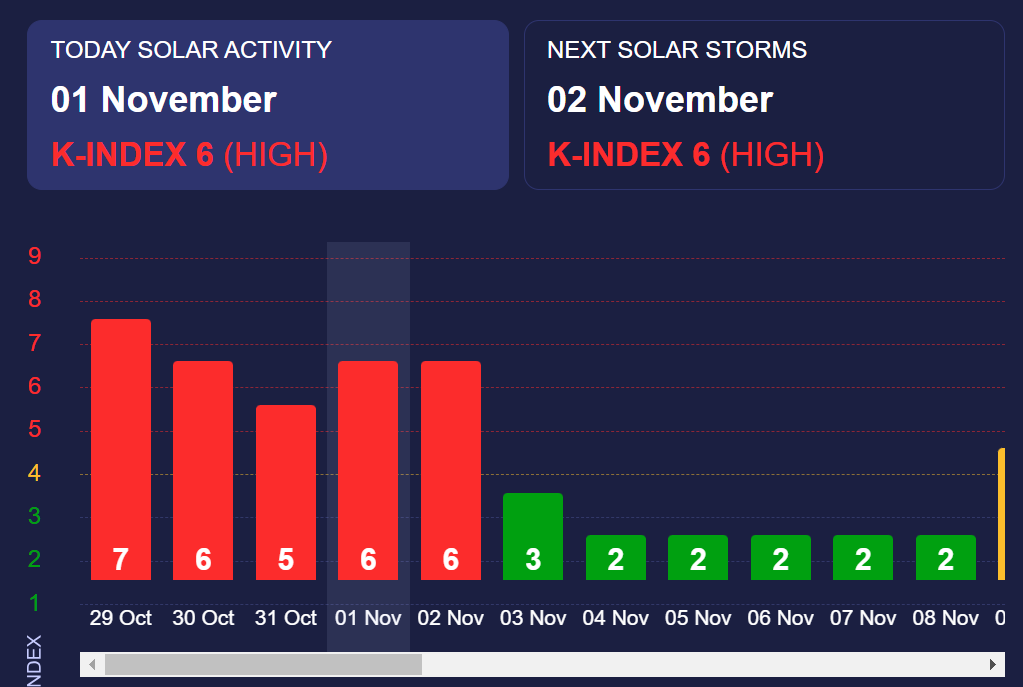Two-day magnetic storm: When will it be risky?
 Two-day magnetic storm will hit Earth (RBC-Ukraine collage)
Two-day magnetic storm will hit Earth (RBC-Ukraine collage)
A strong magnetic storm of the red level will hit Earth today, November 1. It will persist and storm into tomorrow. This storm will reach a high K-index of 6. This means that many people on the planet may experience headaches and deteriorating well-being, according to Meteoagent.
What is a magnetic storm
Solar flares and storms provoke the release of solar energy, leading to an elevated geomagnetic environment. Solar energy from such eruptions scatters in various directions, including towards the Earth.
This energy is made up of charged particles, such as protons and electrons, which travel through space at extremely high speeds. When these particles reach the Earth, they interact with our magnetic field and atmosphere, resulting in a variety of effects.
Scientists classify such storms by their strength. Minor magnetic fluctuations are usually hardly noticeable; these are storms with K-index 2 to K-index 3. A K-index 4 storm is considered moderate.
Storms with a K-index of 5 and above are already at the red level and can be noticeable. Such storms can cause disruptions in the operation of electronics, satellites, mobile communication, and GPRS. Stronger storms can lead to polar auroras.
Moreover, storms with a K-index above 5 can affect people's well-being on the planet.
What is known about the upcoming magnetic storm
According to data from satellite systems NOAA, TESIS, and international meteorological laboratories worldwide, a powerful magnetic storm with a K-index of 6 will hit Earth in the second half of the day on November 1.
The previous few days were not calm, although scientists predicted that the storm would subside on November 1. However, this storm will persist for two more days, and on November 2, an increase in geomagnetic activity to a K-index of 6 is expected.
The magnetosphere will only return to a calm state on Friday, November 3.

How does a magnetic storm affect people
Among scientists worldwide, there is no consensus on the impact of magnetic storms on human health. There are many studies that confirm the correlation between magnetic storms and a decline in human well-being.
During such days, people may experience discomfort and are more likely to seek medical attention, especially from cardiologists.
Common complaints include:
- Headaches, migraines, dizziness
- Insomnia, excessive daytime sleepiness
- General weakness and a decline in well-being
- Rapid fatigue, decreased concentration, and productivity
- Increased anxiety, depression, irritability, and aggression
The greatest danger posed by such storms is to astronauts outside the protective shield of the Earth's atmosphere. They can be exposed to high levels of radiation, significantly increasing the risk of developing cancer.
How to ease your condition during magnetic storms
If you are weather-sensitive and experience a decline in well-being during magnetic storms, doctors usually recommend the following:
- Get enough rest and sleep - at least 7-9 hours of sleep per night.
- Reduce physical and emotional stress.
- Breathe fresh air and drink enough water.
- Maintain a balanced diet and avoid alcohol, salty, and unhealthy food.
- Reduce stress and workload.
- If necessary, consult a doctor.
This material is for informational purposes only and should not be used for medical diagnosis or self-treatment. Our goal is to provide readers with accurate information about symptoms, causes, and methods of detecting diseases. RBС-Ukraine is not responsible for any diagnoses that readers may make based on materials from the resource. We do not recommend self-treatment and advise consulting a doctor in case of any health concerns.

